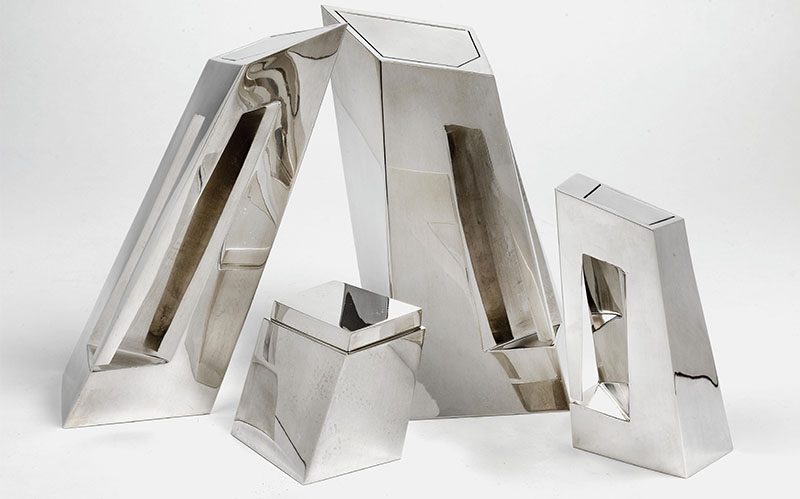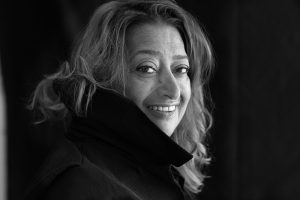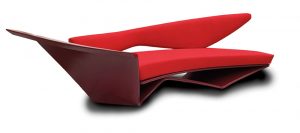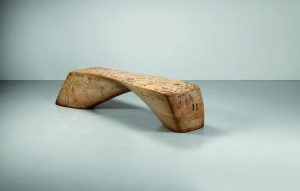
Everything is fluid
The name Zaha Hadid is practically a label itself. It stands for a visionary architectural aesthetics that includes every variation of design. The multi-facetted nature of Hadid’s career is richly demonstrated by her many works sold by Dorotheum over the past 20 years.

The London-based Iraqi-British architect, who recently passed away at age 65, managed to always transcend the modern versus postmodern discourse with her unique spacial concepts. Hadid’s designs were often deemed unfeasible during her early career, yet she never abandoned or lost faith in the visionary conceptional approach:
“I do believe that I’m able to express something with architecture that we didn’t think possible – an order of things, a different view of the world,” she has said.
The earliest sources of inspiration to Hadid, who grew up in a liberally minded family in Bagdad, were local buildings by international star architects, commissioned as part of the efforts to modernize Bagdad. Le Corbusier had been commissioned to build a sport complex, Frank Lloyd Wright a cultural centre and Walter Gropius a university campus.
Not only one perspective
Audacious linearity and multiple perspectives quickly became recognisable trademarks of Hadid’s works whether it be major projects such as the Guangzhou Opera House or the Bergisel ski-jump by Innsbruck, or modestly-sized sofas or tea and coffee sets.
Hadid was honored in 2004 for her immense contribution to architecture with the Pritzker Architecture Prize, architecture’s equivalent of the Academy Award. From start to finish, her intellectual approach to architecture was deeply rooted in the work of Soviet constructivist and suprematist painter Kasimir Malewitsch.
“We are only truly capable of perceiving space if we free ourselves from the Earth, if our point of reference disappears,” she quoted Malewitsch in her final dissertation at the Architectural Association in London. At the time, she was planning to build a hotel on a London bridge. Conventional architectural drawings were never enough. She applied Malewitsch’s sense of abstraction as an investigative principle in her work and pursued it with vigor. His influence she described like this: “All my work was a continuation of his ideas, for example on fragmentation, curvature and clustering. The ideas about lightness, about fluidity and permeability they all originate from this pursuit.”
Hybridisation, transformation, deterritorialisation and deformation serve as guiding principles. Karl Lagerfeld, who commissioned Hadid with the design for an exhibition pavilion in 2007, praised her as “the first architect to find a way to fully decouple from the dominant post-Bauhaus aesthetics”.
According to architectural historian Philip Jodidio, Hadid’s works “are all similar in the fluidity of layout and the dynamism of space and surface”.
Being aloof and futuristic, yet cool, elegant and practical:

a tricky balancing act that Hadid always managed to pull off in grand fashion, exemplified admirably by her “Project in Red” sofa, of which a specimen was sold by Dorotheum for 8,250 euros earlier this year. The sofa was part of the so called “Wave” collection. It was launched at Milan night club “Studio 54” in 1988 and categorised as explicitly avant-garde. The designs were realised by Italian firm Edra, whose creative director at the time, Massimo Morozzi, was also an architect. At a spectacle of a show, three sofas by Hadid were unveiled, one of them being the “Woosh” sofa. A seating accommodation which evokes the impression of solidified movement, the sofa effectively embodies the conceptional quality of Hadid’s finest work. Woosh became an instant success and was serially produced in limited editions the following years. The “Project in Red” sofa was never serially produced and is extremely rare.
Flow of light
With the “VorteXX Chandelier”, Zaha Hadid added a new dimension to lighting. The seemingly fluid glass fibre-enforced polyester chandelier appears to ooze lazily from the ceiling to form an organic serpentine shape. It’s equipped with LED-modules that create a multitude of different colours and moods. A VorteXX Chandelier No. 6, designed in 2005 by Hadid and Patrick Shuhmacher and manufactured by Austrian lighting firm Zumtobel, collected an impressive 151,800 euros at a Dorotheum auction in 2010.

Lighting object, furniture or sculpture? In the case of Hadid, the boundaries are, quite obviously, fluid. A convincing example is the colossal, organically shaped and suitably named “Flow” vase. A design liebhaver paid the stately sum of 75,000 euros for a specimen of the vase with the serial number 12 from an edition of 12 at an auction earlier this year.
Hadid’s fragmentation doctrine is illustrated particularly well by her 1997-conceived tea and coffee set, which is reminiscent in style and appearance to her earliest realised building project, the Vitra fire station in Weil am Rhein. The set was manufactured in a series of ten by Sawaya & Moroni. Its four pieces are all uniquely shaped, put together like a 3D-puzzle they form a coherent whole that could easily be mistaken for a bold architectural model.
The solid ash Ordrupgaard Bench sold by Dorotheum earlier this year, though, is decisively one of a kind. Four copies were manufactured in connection with the United Nations Climate Change Conference in Copenhagen in 2009, but this bench, Mod. PP 995, was subsequently signed by all the conference participants. It sold for 50,000 euros.

The solid ash Ordrupgaard Bench sold by Dorotheum earlier this year, though, is decisively one of a kind. Four copies were manufactured in connection with the United Nations Climate Change Conference in Copenhagen in 2009, but this bench, Mod. PP 995, was subsequently signed by all the conference participants. It sold for 50,000 euros.
The Zaha Hadid universe can never be explained through individual works. Like no other she was capable of creating unique urban environments and spaces that possessed a timeless quality. As shocking as her untimely death was, as comforting it is to know that her ideas will be preserved in the future by her studio.













